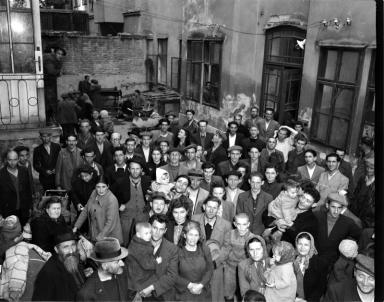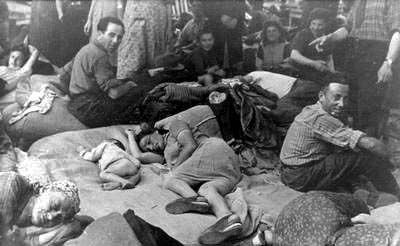Vienna / Wien City Archives: http://www.magwien.gv.at/
Magistrat der Stadt Wien - MA 8 -
Wiener Stadt- und Landesarrchiv
Rathaus
A 1010 Wien 1
Besucheradresse: Rathaus, Stiege 6, 1. Stock, Tür 328, 1082 Wien,
Email: post@m08.magwien.gv.at
Tel: +43 (1) 4000-84808 and +43 (1) 400099-84819
Fax: +43-1/4000-7238
Other archives:
Erzbistum Wien, Diözesan archiv, Wollzeile 2, 1010 Wien
Technische Universit&3228;t, Archiv, Karlsplatz 13, 1040 Wien
Universität Wien, Universitätsarchiv, Postgasse 9 (Alte Universit&3228;t), 1010 Wien
US Zones:
Wien IX Rothschild Hospital Severingasse,
Stadteil Alsergrund, UNRRA camp 350, Durchgangslager,
600 Jews,
Crowded conditions meant many families slept in the same room.
Wien IX Alserbachstrasse Stadteil Alsergrun transit camp Wien XVII Arzbergengasse No. 2 Stadteil Hemals, subcamp of Rothschile Hospital, former school Wiex XVII Rupertsusplätz, Dombach, Stadheil Hemals, former schoolSoviet, Great Britain, French zones on Danube river, Haupstadt & Bundesland, Ukrainians The Soviets bring in the peas....
The first 12,000 tons of food were brought to Vienna from Soviet crew power to the order - the peas in doses became for the first months after end of war the basis of the nutrition. The weekly food dispatching consisted first of a half loaf bread, 50 g fat and peas. Starting from March 1946, the arriving auxiliary supplies of the UNRRA (United National Relief and Rehablitation Administration) brought in June 1947 to Austria supplies of food, seeds, fertilizers, clothing and also motor vehicles in the value altogether from 419 million US dollar.
In the autumn 1947 the boarding set per day for ordinary consumers could be increased from 1.550 calories to 1.700 calories. After an interim aid, which guaranteed free American food supplies due to the "inter-CIM assistance agreement," the supplies began under ERP (European Recovery Program) in the autumn 1948. Marshall Plan. Now the food plan was set on 2,100 calories. Also different states, which had suffered still few years before from the German war guidance, helped: Great Britain promoted the reconstruction of nourishing natures, agriculture and industry with 10 million Pound. Canada placed 3.4 million kanad. dollar ready, Norway 4 million norwegian crowns. Ireland sent a food assistance of 500 tons frozen meat. For the distribution of the supplies a "nourishment administration" was developed. The elbow stretched itself from men of confidence in the villages concerning the self-applying and/or government agencies concerning the America assistance over the controlling gendarmerie and police to the offices for nourishing of the countries and the map places and finally to the Hausbesorgern.
The office for national nourishment in Vienna had to regulate the distribution, whereby daily approx. 510 tons of flour, 66 tons of fat, 156 tons of naehrmittel and 77 tons of sugars were used. Task of the market office officials at that time was to track the benefit fitness of the food to respected and a control function concerning their distribution. In this time - however illegal - a trade, the smuggling trade flowered. Central approach place for offerers and searches was the Resselpark. Here so some valuable schmuckstueck was exchanged for a kilogram fat, or a valuable hereditary piece for something meat. The office for market was an important instrument in the fight against black market operators, who struck profit from emergency and despair of the Bevoekerung.
Under co-operation of the police 1948 food in a delivery volume of approx. became to end. 2,000 Wagonfrachten seizes and the tidy management supplied. At the 11. January 1949 bread and flour rationing could be waived. On 31 August 1950 the food management law ceased to apply, which terminated rationing of the food. From the war heavily in also the Viennese markets had pulled. From altogether 41 markets of the Vorkriegszeit 9 was completely burned-down, among them the Karmelitermarkt, the Augustinermarkt and/or Rochusmarkt, the Viktor eagle market and the Floridsdorfer market. War damage like individual bomb and/or garnet hit almost all market surfaces, which were glazings of market halls with majority destroyed. Soon after the end of war, the repair works at the market were begun, majority of the repairs made by the operators themselves, since most of the Viennese markets the buildings of conditions are private property.
Computer translation from website: Stadt Wien archives This site has a search box.
Living in Vienna under Russian occupation; Timewitnesses.org
THE CENTRAL ARCHIVES
FOR THE HISTORY OF THE JEWISH PEOPLE
Location: Hi-Tech Village 3/4, Giv'at Ram Campus, Hebrew University of Jerusalem
Postal Address: POB 39077, Jerusalem 91390
Tel. 972-2-6586249
Fax 972-2-6535426
E-Mail: archives@vms.huji.ac.il
3/18/08 I
am working at the Central Archives for the History of the Jewish
People and am currently sorting out documents from the Jewish
community in Vienna after WW II (mainly 1945-1951). Among others,
the material contains about 15 big boxes with documents on the
DP camps in Vienna and mainly on the "International Committee
for Jews from Concentration Camps and Refugees" in Vienna.
I used your website to verify the names and addresses of the
DP locations in Vienna that were mentioned in the documents.
So far I came across 3 camps which are not mentioned in your
excel list of camps in Austria. They are the following: Frankgasse
2, Pezzelgasse 29 (was active till Aug. 1948) and Goldschlagstrasse
108.
Our Archives also hold the records of the Jewish
community of Vienna before W.W.II. This material
has been catalogued about 40 years ago. The material
from after WW II on which I am working now is very
interesting and contains much information on the
DPs. A major part of the material are lists of the
DPs in the vrious homes, mainly the Rothschild hospital
the Arzbergerheim and the Frankgasse 2.
Denise Rein
"...threats, kidnappings ... soon changed the tone of Soviet repatriation. DPs began disappearing from streets ...after several Ukrainians were seized in Vienna, presumably by Soviet agents, ... "Ukrainian life in Vienna is dead, people are terrorized." (Wyman, p.75) Ukr. Univ. & technical schools were here (Wymn, p. 123).
Dear Olga:
My name is Lynne and I am trying to find out what happened to my father's
parents and his sister. They lived in Vienna. My father was able to find
a sponsor and get to the USA. He arrived here in 1939. His other sister
was in Brussels and when Hitler took over there she was then hidden. Letters
from his parents stopped around 1942. After the war, my father tried to
located them, as well as his sister in Brussels, but neither one could
find anything. In a letter I found from my father to his sister, he thinks
his sister was sent to a labor camp in Germany.
I would really appreciate any help, guidence or whatever on where to begin to find any reference as to what happened to them. I did go to Washington DC and look in the holocaust museum but found nothing. My e-mail address is: sunsts27@aol.com. Thank you for your assistance. Sincerely, Lynne L.

